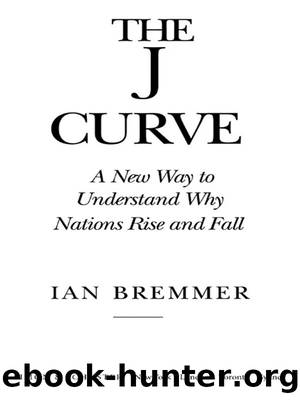The J Curve by Ian Bremmer

Author:Ian Bremmer
Language: eng
Format: epub
Publisher: Simon & Schuster
Published: 2006-09-14T16:00:00+00:00
The End of Apartheid
In the mid-1980s, the National Party’s battle with domestic antiapartheid resistance came to a head. There were 469 strikes in South Africa in 1984. By 1987, the number had climbed to 1,148—an average of more than 3 a day.1 While reliable figures are hard to come by, a number of credible press reports suggest that thousands were arrested and held without charges between 1984 and 1988; thousands more were killed in political violence.
During the 1980s, the South African government’s struggle with external opposition also reached a critical moment, as the sanctions movement gathered momentum. While the United States was slow to join the international isolation of South Africa, the Treasury Department issued South African Transactions Regulations in 1985, which prohibited loans to South Africa by U.S. financial institutions. A year later, the Comprehensive AntiApartheid Act ended trade in agricultural products and banned U.S. loans to, and investments in, South Africa’s private sector.
African states added to the pressure. Liberation movements in Mozambique, Zimbabwe, and Namibia became what they called “frontline states” against apartheid South Africa. Tanzania, Algeria, Ghana, Zambia, and Botswana provided material and financial support to the ANC and other black South African political organizations.
By 1989, the leadership of the minority white government began to recognize that the costs of international isolation, protection from black anger at home, and the stability of South Africa’s place on the left side of the J curve could not be sustained. Even as Mikhail Gorbachev was leading the Soviet Union into the most ambitious perestroika-inspired reforms, South African President P.W. Botha entered into secret talks with the only man in the country considered a legitimate representative of the black South African majority, Nelson Mandela.
In September 1989, as left-side-of-the-curve states like Poland, East Germany, and Czechoslovakia tottered on the edge of collapse and Yugoslavia faced civil war, F. W. de Klerk—who had become president after Botha suffered a stroke—released opposition leader Walter Sisulu and several other antiapartheid fighters from prison.
On February 2, 1990, de Klerk lifted the ban on the ANC and several other black African parties. Nine days later, exactly thirty days before the Soviet Congress of People’s Deputies abolished the Communist Party’s constitutional monopoly on power, Nelson Mandela emerged from his prison cell.
On March 18, 1992, less than three months after the collapse of the Soviet Union, a referendum was held in which white South Africans were asked to decide the country’s future. Nearly 70 percent of them voted to end apartheid and for the construction of a power-sharing multiracial government. In 1993, a government of national unity was formed that combined members of the old regime and representatives of the African National Congress. Twenty-one political parties approved an interim constitution.
South Africa held its first democratic elections in 1994. Nelson Mandela was elected president. De Klerk and the ANC’s Thabo Mbeki were chosen deputy presidents.
Download
This site does not store any files on its server. We only index and link to content provided by other sites. Please contact the content providers to delete copyright contents if any and email us, we'll remove relevant links or contents immediately.
International Integration of the Brazilian Economy by Elias C. Grivoyannis(57322)
The Radium Girls by Kate Moore(10907)
Turbulence by E. J. Noyes(7038)
Nudge - Improving Decisions about Health, Wealth, and Happiness by Thaler Sunstein(6633)
The Black Swan by Nassim Nicholas Taleb(6190)
Pioneering Portfolio Management by David F. Swensen(5606)
Rich Dad Poor Dad by Robert T. Kiyosaki(5147)
Zero to One by Peter Thiel(4824)
Man-made Catastrophes and Risk Information Concealment by Dmitry Chernov & Didier Sornette(4735)
Secrecy World by Jake Bernstein(3782)
Millionaire: The Philanderer, Gambler, and Duelist Who Invented Modern Finance by Janet Gleeson(3568)
Skin in the Game by Nassim Nicholas Taleb(3459)
The Age of Surveillance Capitalism by Shoshana Zuboff(3422)
The Money Culture by Michael Lewis(3284)
Skin in the Game: Hidden Asymmetries in Daily Life by Nassim Nicholas Taleb(3264)
Bullshit Jobs by David Graeber(3179)
The Dhandho Investor by Mohnish Pabrai(3168)
The Wisdom of Finance by Mihir Desai(3078)
Blockchain Basics by Daniel Drescher(2890)
